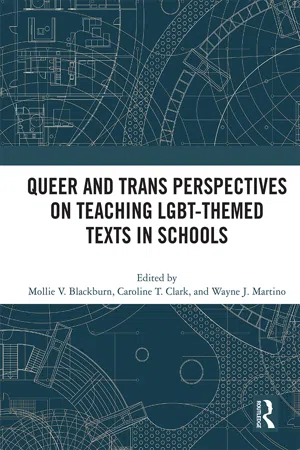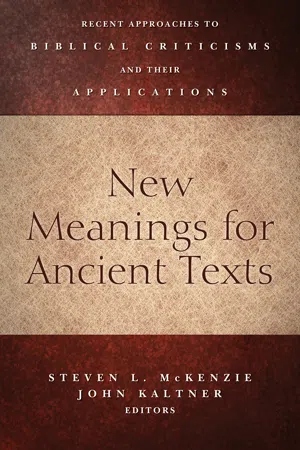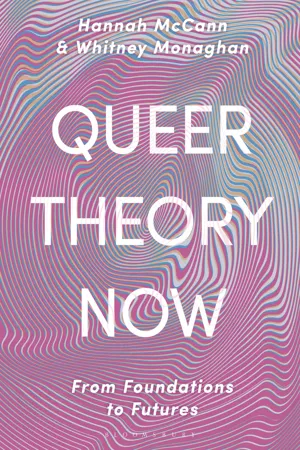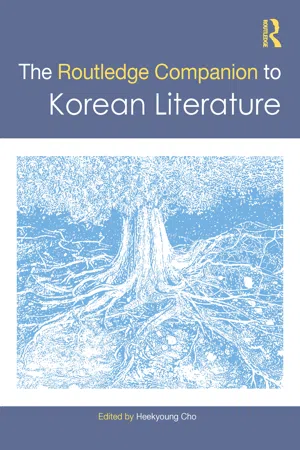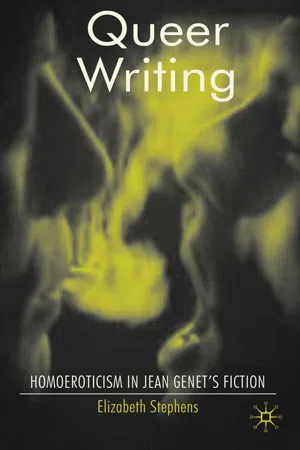Literature
Queer Literature
Queer literature encompasses works that explore LGBTQ+ themes, characters, and experiences. It often challenges traditional norms of gender and sexuality, offering diverse perspectives and narratives. This genre of literature provides a platform for marginalized voices and contributes to a more inclusive literary landscape.
Written by Perlego with AI-assistance
Related key terms
1 of 5
10 Key excerpts on "Queer Literature"
- eBook - PDF
- J.L. Mey(Author)
- 2009(Publication Date)
- Elsevier Science(Publisher)
Thus, ‘queer’ in-cludes (but is not restricted to) all sexual and gender minorities. In this usage, the actual membership in a ‘queer’ community is left intentionally vague because ‘queer’ is defined not in terms of who belongs but in terms of what queers react against. Thus, the common denominator for queers is their marginalization and exclusion rather than being unified by some common identity or shared social practices. The ‘queering’ of academic disciplines was proposed as a means of turning attention toward those individuals who had been traditionally marginalized in social theory. By focusing on individuals who are not prototypi-cal members of traditional (etic) identity cate-gories, queer theory attempts to gain insight into the normative forces that underlie social practice. Research that falls within the realm of queer linguis-tics does not always deal with speakers who are gay, lesbian, or transgendered but may deal with speakers who are marginalized in other ways, as with Mary Bucholtz’s (1999) research on the language of self-proclaimed ‘nerds.’ Within linguistics, this use of ‘queer’ has been adopted by those working in ‘queer linguistics’ (Barrett, 1997, 2002; Bucholtz and Hall, 2003, 2004; Hall, 2003; Livia and Hall, 1997a) in an attempt to adopt and amend proposals from queer theory into a frame-work for the study of language. Although ‘queer’ with-in queer linguistics was intended to refer to queer theory (rather than any community of actual queers), this use of ‘queer’ has been criticized primarily on the grounds that it does not refer to any externally definable social group (Kulick, 2000; Leap, 2002). In contrast to so-ciolinguistic frameworks focusing on norms of lan-guage variation that categorize individuals into speech communities based on etic identity categories, queer linguistics assumes that speech communities are prototype categories that do not have clearly definable boundaries. - Mollie V. Blackburn, Caroline T. Clark, Wayne J. Martino, Mollie V. Blackburn, Caroline T. Clark, Wayne J. Martino(Authors)
- 2018(Publication Date)
- Routledge(Publisher)
Kumashiro (2000) in his theorization of anti-oppressive education notes, that ‘oppression originates in discourse, and, in particular, in the citing of particular [harmful] discourses, which frame how people think, feel, act, and interact’ (p. 40). Queering reading practices, therefore, means to dismantle essentializing understandings of what it means to be lesbian, gay, bisexual, transgender, or queer toward revealing identities as discursively and performatively produced and reproduced within regulatory regimes of control (Butler, 1990/2006; Foucault, 1978/1990). Through its focus on the deconstructive analysis of texts and discourses, queer theorizing opens intellectual spaces for alternative conceptualizations of knowledge and new lines of thought that serve as interruption not reproduction related to sexualities and gender diversity (Tierney & Dilley, 1998).Drawing on the work of these scholars, I propose a multidimensional theoretical framework and pedagogical approach that bridges queer theorizing to critical literacies teaching. This queer literacies (QL) framework draws in particular on the central tenets of critical literacies, anti-oppressive education, and queer pedagogy (e.g. Atkinson et al., 2010; Britzman, 1995; Bryson & de Castell, 1993; Butler, 1990/2006; DePalma & Atkinson, 2008; 2009; Killoran & Pendleton Jiménez, 2007; Kumashiro, 2002; Lewison, Flint, Van Sluys, & Henkin, 2002; Meyer, 2010; Wallowitz, 2008) for creating, implementing, engaging students with, and analyzing curricula that focus on sexualities and gender diversity.2 In developing the six dimensions of the QL framework, I suggest that such an approach should include the following interconnecting six dimensions or pedagogical moves (Figure 1 ):In particular, the QL framework places readings within the social, cultural, and historical contexts in which sexualized and gendered identities are produced and situated (QL Dimension 1). It engages students in interrogations of various systems of oppression related to sexuality and gender (i.e. homophobia, heterosexism, heteronormativity, cissexism, genderism, and transphobia) and emphasizes the importance of an intersectional analysis that explores the intersections of sexuality and gender with issues of race, ethnicity, social class, ability, religion, and other markers of difference (QL Dimension 2). A QL approach seeks to trouble commonsense knowledge of diverse sexuality and genders, flips the readers’ analytical gaze through interrogations of normative frameworks and the notion of normalcy, and involves students in unlearning the partial, often harmful, and distorted understandings that students already hold around LGBTQ issues when entering the classroom (QL Dimension 3). It adopts alternative reading processes which highlight the gendered and heteronormative constructions of a text and where questioning assumptions and asking critical questions perform important work in deconstructing hegemonic discourses that structure knowledge about sexuality, gender, and sex (QL Dimension 4). It pays particular attention to queer counter-narratives and how these disrupt, alter, and rework oppressive discourses (QL Dimension 5). Finally, a QL approach recognizes crisis as a potential catalyst for change, asking teachers to create spaces in the curriculum where students can enter and work through emotional discomfort and/or cognitive dissonances (QL Dimension 6). (For a more detailed discussion of the QL framework see Helmer, 2015a, in press).- eBook - ePub
New Meanings for Ancient Texts
Recent Approaches to Biblical Criticisms and Their Applications
- Steven L. McKenzie, John Kaltner, Steven L. McKenzie, John Kaltner(Authors)
- 2013(Publication Date)
- Westminster John Knox Press(Publisher)
2 It would not be quite right to call the resulting queer criticism a method, if by method one means a set of agreed upon steps that reliably lead disciplined readers to shared conclusions. However, queer criticism can be understood as a kind of interpretive sensibility or style of reading, which shapes particular interpretations of texts to varying degrees.Although it will be important to keep in mind the heterogeneity of queer commentary that Berlant and Warner emphasize, in this chapter the most significant characteristics of queer criticism include the following:- Queer criticism calls attention to sexual practice and gender, often in relation to one another, as key sites for the interpretation of cultural, social, and textual meanings and practices.
- Queer criticism emphasizes the fact that meanings and practices associated with sex, gender, and kinship vary significantly across cultures and histories, or even within a single culture. This emphasis contrasts with all attempts to stabilize the meanings and practices associated with sex, gender, or kinship by grounding them in a supposedly unchanging nature, assumed cultural universals, or religious revelation.
- Working under the influence of thinkers and ideas associated with “queer theory,” queer criticism tends to be suspicious of organizing sexual and gender meanings too rigidly around stable binary oppositions such as male and female, masculine and feminine, or heterosexual and homosexual. Instead, queer criticism emphasizes the fluidity and unpredictability of gender, sexual desire, and sexual practice, as well as the instability of the binary oppositions that are thought to structure them.
- The tendency for readers (including scholars) to universalize a particular set of modern, Western norms for sexual practice, gender roles, and family structures is analyzed critically by queer criticism as “heteronormative.” At its most basic, “heteronormativity” is the institutionalized preference for opposite-sex sexual relationships over same-sex sexual relationships. However, a number of other assumptions and practices are also associated with heteronormativity, including the beliefs that binary gender roles follow naturally from biological sex; that sexual desire and sexual practice follow from gender roles and/or biological sex; that an individual’s biological sex, gender roles, sexual desires, or sexual practices are consistent over time; that kinship units ideally form around a monogamous, opposite-sex couple; and that sexual activity is most appropriately aimed at romantic love, reproduction, and childbirth. Although heteronormativity may appear to be self-evidently good to its supporters, queer criticism notes that heteronormativity often leads to the marginalization or persecution of individuals and populations who fall short of its ideals.
- eBook - PDF
Queer Theory Now
From Foundations to Futures
- Hannah McCann, Whitney Monaghan(Authors)
- 2019(Publication Date)
- Bloomsbury Academic(Publisher)
1 1 Defining Queer Theory KEY TERMS AND CONCEPTS queer, queering, genealogy, the gender binary, LGBTIQ, norms, normalisation, normative, normativity, heteronormativity, anti-normativity, postqueer DEFINING THE INDEFINABLE How can theory be “queer”? What is the difference between queer identity, queer politics and queer theory? Is queer theory always related to sexuality in some way? The aim of this book is to help make sense of these questions by tracing queer theory across a range of historical contexts. As we find, though queer identity, politics and theory can be understood to offer separate and often conflicting approaches, a historical lens helps us understand how these tensions have come to be. We find that we cannot understand what queer the-ory “now” is, without looking backward, and at times, rethinking a few grand narratives. It is often said that queer theory is difficult to define, or that it is anti-thetical to the spirit of the theory to tie it down to a single meaning. As we will see throughout this book, queer is a “deliberately ambiguous term” that is simultaneously a way of naming, describing, doing and being (Monaghan 2016 , 7). This is where queer theory finds its radical potential as a term to challenge, interrogate, destabilise and subvert, but it also means there is diffi-culty in pinpointing queer theory’s meaning. As Annamarie Jagose notes, it is “a concept that prominently insists on the radical unknowability of its future formations,” that maintains a “strategically open-ended relational character” (2009, 158). Or, as Donald Hall has argued, we must understand queer theory in the plural: “there is no ‘queer theory’ in the singular, only many different voices and sometimes overlapping, sometimes divergent perspectives that can be loosely called ‘queer theories’” (2003, 5). Queer theory is, it seems, mercu-rial (Dilley 1999 ). - eBook - PDF
- Mary Klages(Author)
- 2006(Publication Date)
- Continuum(Publisher)
As the prevalence of the structure of the binary opposition tells us, once you set up a category labeled ‘normal,’ you automatically set up its opposite, a category labeled ‘deviant,’ and the specific acts or identities which fill those cat-egories then get linked to other forms of social practices and methods of social control. When you do something your culture labels deviant, you are liable to be punished for it: by being arrested, by being shamed, made to feel dirty, by losing your job, your license, your loved ones, your self-respect, your health insurance. Gay/lesbian studies, LITERARY THEORY: A GUIDE FOR THE PERPLEXED 116 like feminist studies, works to understand how these categories of normal and deviant are constructed, how they operate, how they are enforced, in order to intervene into changing or ending them. Which brings me – finally – to queer theory. Queer theory emerges from gay/lesbian studies’ attention to the social construction of categories of normative and deviant sexual behavior. But while gay/lesbian studies, as the name implies, focused largely on questions of homosexuality, queer theory expands its realm of investigation. Queer theory looks at, and studies, and has a political critique of, anything that falls into normative and deviant categories, particu-larly sexual activities and identities. The word ‘queer,’ as it appears in the dictionary, has a primary meaning of ‘odd,’ ‘peculiar,’ ‘out of the ordinary.’ Queer theory concerns itself with any and all forms of sexuality that are ‘queer’ in this sense – and then, by extension, with the normative behaviors and identities which define what is ‘queer’ (by being their binary opposites). Thus queer theory expands the scope of its analysis to all kinds of behaviors, including those which are gender-bending as well as those which involve ‘queer’ non-normative forms of sexuality. - eBook - ePub
Critical Concepts in Queer Studies and Education
An International Guide for the Twenty-First Century
- Nelson M. Rodriguez, Wayne J. Martino, Jennifer C. Ingrey, Edward Brockenbrough, Nelson M. Rodriguez, Wayne J. Martino, Jennifer C. Ingrey, Edward Brockenbrough(Authors)
- 2016(Publication Date)
- Palgrave Macmillan(Publisher)
© The Author(s) 2016Begin AbstractCritical Concepts in Queer Studies and Education Queer Studies and Education 10.1057/978-1-137-55425-3_26Nelson M. Rodriguez ,Wayne J. Martino ,Jennifer C. Ingrey andEdward Brockenbrough (eds.)Queer Literacy Framework
End Abstractsj Miller 1(1) New York University, Metropolitan Center for Research on Equity and the Transformation of Schools, New York, NY, USAHistoriography: Building the Queer Literacy Framework
Gender and sexuality norms, conscribed under heteropatriarchy—a history we never made—have colonized and established violent and unstable social and educational climates for the millennial generation of lesbian, gay, bisexual, trans*, intersex, agender/asexual, gender creative, and questioning youth (LGBT*IAGCQM ) (Miller 2014c ). While many studies by the Gay, Lesbian, and Straight Education Network (GLSEN) and their allies show that LGBT*IAGCQM students feel safer overall in schools than their LGBT*IAGCQ predecessors, due to shifts in national and state policies and amendments advocating for LGBT rights, state antibullying laws, increased numbers of Gay–Straight Alliances, and a wider social acceptance of LGBT*IAGCQ people, schools still struggle to normalize the inclusion of an LGBT*IAGCQ-positive curricula (GLSEN 2011 , 2013 ; Kosciw et al. 2010 ). This work addresses, through a queer literacy framework (QLF), how teacher educators can support preservice teachers to understand and read (a)gender and (a)sexuality1 - eBook - ePub
- Heekyoung Cho(Author)
- 2022(Publication Date)
- Routledge(Publisher)
Despite the increasing interest in Queer Literature in the literary field, there is still an imbalance of critical and scholarly attention in terms of genre diversity, as more scholarly or critical attention has been given to prose than to other literary forms. In fact, analyses of prose, especially novels and short stories, overwhelmingly outweigh those of other genres in number. In particular, there is a notable dearth of criticism that highlights queerness in poetry, except for a few scholarly endeavors analyzing collections of poems with explicitly queer subjects, such as Hwang Pyŏngsŭng’s Shik’ok’u, the Cross-dresser and Kim Hyŏn’s Glory Hole (Kŭllori hol). Even considering the relative popularity of prose in the reading population, the near absence of criticism of queer poetry is surprising. The relative dearth of studies on queer poetry at least partially reflects the tendency in criticism to find the interpretative clue of queerness in either the author’s personal stake or the obvious representation of non-normative sexuality, as poetry often “detours” the narrative by using figurative language and imagery. The only comprehensive study overviewing queer Korean poetry thus far is an article by Chŏng Kkŭtpyŏl. Chŏng also heavily relies on the significance of authorial agency in appreciating queer poetry. She argues that “the politics of queer is guaranteed through Tangsajasŏng and the representational strategy” (Chŏng 2020, 42). While depreciating queer poetry by Hwang Pyŏngsŭng as a literary representation of an “androcentric sexuality based on bi-gender dichotomy” (Chŏng 2020, 40), Chŏng praises poems by Kim Hyŏn as a poetic example of “the power of speech originated from one’s self-identification and self-description as well as the politics of the very power” (Chŏng 2020, 43) - eBook - ePub
Living Out Loud
An Introduction to LGBTQ History, Society, and Culture
- Michael Murphy, Brytton Bjorngaard, Michael Murphy, Brytton Bjorngaard, Michael J. Murphy, Brytton Bjorngaard(Authors)
- 2018(Publication Date)
- Routledge(Publisher)
Authors such as Emily Dickinson, Tennessee Williams, and Alice Walker (to name only a few) lived lives or wrote about characters with complex sexual attractions, behaviors, and desires having expansive and fluid gender identities and expressions. These authors are frequently studied in high-school English classrooms, opening a prime opportunity for students to consider the significant contributions of LGBTQ + authors and texts to academic literary culture (Greenbaum, 1994). Providing students with opportunities to consider themes, subtexts, and language that speaks to same-sex attraction or to gender-expansive perspectives may expand students’ understanding of literary aesthetics beyond the politics of identity and representation. Family dynamics, love, belonging, power, and the complexities of the natural world are all examples of literary topics discussed in the English classroom that, when viewed through an LGBTQ + lens, can open the door for literary interpretations that reject normative perspectives and create classroom climates embracing a range of voices. Additionally, examinations of how masculine and feminine are portrayed in literary characters and by authors offers students opportunities to disrupt gender expectations and see the spectrum of gender performances represented in literature. Finally, teachers and students can learn to engage in “queer readings” of texts (Shlasko, 2005, p.130). This approach requires readers not only to identify and name LGBTQ + or gender expansive elements presented in a text, but also to interpret texts based on alternative understandings. For example, instead of asking, “What’s the text say and mean?” students might ask, “What else could this text mean?” and “What did I want to find or avoid finding in the text?” (Kumashiro, 2002). These questions push students to shift assumptions about gender and sexual orientation - eBook - PDF
Queer Writing
Homoeroticism in Jean Genet's Fiction
- E. Stephens(Author)
- 2009(Publication Date)
- Palgrave Macmillan(Publisher)
As a number of recent queer theorists have argued, queer studies may not be able to manage without a stable idea of queerness as the basis of political action and community formation; it may need a reasonably stable notion of sexuality and sexual identity, even under- stood as necessary fictions, in order to function. It is for this reason, as 14 Queer Writing Lisa Duggan notes, that queer theory’s emphasis on destabilisation and fluidity has met with internal resistance, read by some as an attempt to “‘deconstruct[…]” the gay community before it even comes into full visibility’ (57). 15 Just as Elisabeth Daümer cautions that ‘to be queer implies that not everyone is queer in the same way’ (97), recognising the ongoing importance of more traditional concepts of sexual subjectivity to some areas of queer theory reminds us that its celebration of multi- plicity and fluidity also requires accepting other concepts of queer that do not emphasise multiplicity and fluidity. 16 In keeping with Halperin’s observation that queer ‘demarcates not a positivity but a positionality’ (Saint Foucault 61), and the frequently cited formulation in which queer is understood as a verb – a process of interpreting and interacting with texts – rather than a noun – a stable and identifiable property of a text 17 – we might understand queer as a series of multiple and intersecting histo- ries that cannot be reduced to a single orthodoxy. Rather than clarifying – or policing – what queer means, then, we might more productively focus on how queer means. Such an approach provides new ways to undertake queer literary criti- cism and to understand its continued investment in traditional notions of authorship, despite its critique of the concept of stable sexual subjec- tivities. While it is not my intention to attempt to resolve the question of the role of the subject within contemporary queer theory, then, neither do I think it can be simply dismissed or ignored. - eBook - PDF
Beyond Borders
Queer Eros and Ethos (Ethics) in LGBTQ Young Adult Literature
- Darla Linville, David Lee Carlson(Authors)
- 2016(Publication Date)
As YAL has come to em- brace LGBTQ themes, it has done so largely through contemporary realism and the narrative structure of coming-of-age. If contemporary realistic YAL is problematic in forwarding normative beliefs about adolescence, growth, and coming-of-age in general, it is particularly trou- blesome in depicting what coming-of-age might mean for youth who identify as LGBTQ. Queer Theory helps us illuminate the problematics of the coming-out narrative when it is interwoven with the coming-of-age narrative in YAL. In Queer Theory, gender, sex, and sexuality are regarded as unstable, temporal categories that shift over time, across social and cultural contexts, and in response OUT OF THE CLOSET AND ALL GROWN UP | 7 to society’s shifting perceptions on sexuality (and gender, and sex) (Butler, 2004; Marcus, 2005). Queer Theory does not assume a natural link between a person’s gender and their sexual identity or practice (Butler, 2004). While feminist theory highlighted the distinction between one’s assigned (or biological) sex and one’s gender, Queer Theory disconnects sexuality from both, thereby undermining and blurring binary categories of heterosexual/homosexual, male/female, and masculine/feminine (Marcus, 2005; Sykes, 2011). An unstable sexual identity, then, does not indicate a jumping back and forth within the binary of “straight” and “gay.” Instead, sexual desire is based on a host of factors, including context, interaction, preference, etc., which result in many possible (and sometimes conflicting) sexualities. Consistent with the tenets of Queer Theory, several scholars have pinpointed ways in which LGBTQ YAL sometimes works to maintain limited and binary conceptions of sexuality and gender.
Index pages curate the most relevant extracts from our library of academic textbooks. They’ve been created using an in-house natural language model (NLM), each adding context and meaning to key research topics.

